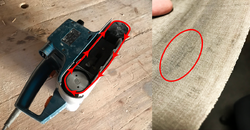Belt Sander: Difference between revisions
(outsourced machine specifics to "AEG HBSE100"; MachineInclusion) |
(→Sanding Belts: no arrows on modern belts) |
||
| Line 8: | Line 8: | ||
[[File:Belt Sander Direction.png|thumb|left|250 px| Turning direction of the belt and markings on the belt.]] | [[File:Belt Sander Direction.png|thumb|left|250 px| Turning direction of the belt and markings on the belt.]] | ||
The belt of a belt sander is directional. Make sure to install it in the correct direction (see illustration) otherwise it will get damaged quickly. | The belt of a belt sander is often directional. Make sure to install it in the correct direction (see illustration) otherwise it will get damaged quickly. | ||
Newer belts may not have such an arrow indication the direction: due to modern splicing techniques, you can run those belts both ways. | |||
<br clear=left> | <br clear=left> | ||
== Stand == | == Stand == | ||
[[File:toy wheel turning 5.JPG|thumb|left|250 px|although a belt sander can be clamped ''very carefully'' in a [[Woodworking Vise|woodworking vise]], we should really make a proper stand for such stationary uses!]] | [[File:toy wheel turning 5.JPG|thumb|left|250 px|although a belt sander can be clamped ''very carefully'' in a [[Woodworking Vise|woodworking vise]], we should really make a proper stand for such stationary uses!]] | ||
Revision as of 16:50, 3 March 2024
A belt sander removes material rather aggressively with the risk of leaving visible sanding marks (lines). However, sometimes power is what you need to tackle rough workpieces, so this machine will be a great addition for woodworking as well as other projects as it can also be used to grind metals. There are even advantages over stone-based grinders such as the larger surface and no chance of exploding stones. Belts may rip and go flying though, especially if they are installed in the wrong direction.
Sanding Belts
If the belt often slips under pressure, it may have become stiff - this may be fixed by "massaging" it a bit in tight bends or replacing it with a new one.
The belt of a belt sander is often directional. Make sure to install it in the correct direction (see illustration) otherwise it will get damaged quickly.
Newer belts may not have such an arrow indication the direction: due to modern splicing techniques, you can run those belts both ways.
Stand

The Spanish Maker Román Palma shared instructions for a nifty three-position stand in Make: magazine, see the article and video here!
With such a stand we could use a handheld belt sander like a stationary sander (although we have a real one now!) or as a simple substitute for a planer (DE: Hobelmaschine) or bench grinder.
